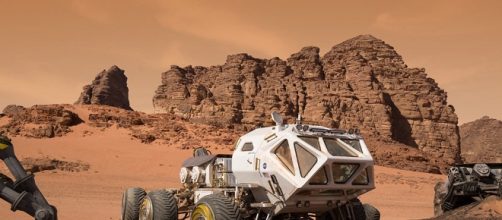Climate change is a reality that affects us every day, despite the growing refusal of big governments - such as the United States - to take a stand on the issue and begin to implement changes that positively affect the effect that being Human and industrialisation continues to have on earth and in the production of natural resources.
Faced with this reality, in which coming generations will face a shortage of basic resources such as water, as well as famine, NASA, the United States space agency, has presented a plan that, although it appears from a science- Fiction, it is viable: the planet Mars could be habitable if a protective magnetic field is created.
This proposal was present at the Visions workshop for Planetary Science 2050.
However, what is a protective magnetic field? It would be a shield - like the ozone layer - to avoid the impact of radiation and solar winds. According to researchers from the Division of Planetary Science of NASA, from the Earth could artificially generate a field of this type, so that the possibilities of inhabiting the planet Mars, are becoming more feasible.
Mars, a habitable planet?
4.200 million years ago, the red planet had a magnetic field that scientists hope to reproduce again. Therefore, the NASA proposal is about recovering Mars from the past, that of millions of years ago, where life was possible and where there was an atmosphere.
Dr Green, one of the scientists involved in the plan to return Mars to a habitable planet, proposes to place a dipole (an element that produces a magnetic field of two opposite poles) as a satellite in the orbit of Mars and so can protect it.
Placing the magnetic field would accomplish several things: divert solar winds, increase the thickness of the atmosphere and raise the planet's temperature by about 4 degrees. In addition, the rise in temperature could melt carbon dioxide, which is very high in the north pole of Mars.
"A Martian atmosphere with higher temperature and pressure would allow enough liquid water on the surface to improve human exploration during the 2040s," Green says. "(...) New conditions on Mars would allow researchers and explorers to study the Planet in much more detail ...
And if this is achieved ... the colonisation of Mars will not be far away. "
An Argentine on Mars
The first mission to Mars is planned for 2030 and, unlike Moon expeditions lasting only weeks, this expedition is planned to last for years (because of the distance separating Earth from the red planet: exactly 80 million Kilometers), so it is necessary to build a house capable of withstanding the extreme conditions of the planet.
The Argentine Pablo León, who has worked as a space engineer in the United States for 20 years, won a contest organised by NASA in 2015 to create a prototype habitat for astronauts going to Mars.
The " Extraterrestrial house" of Leon will have four cabins 12 meters long, independent for privacy, kitchen, dining table, bathroom with shower, scientific area, recreation area and even a greenhouse.

